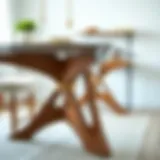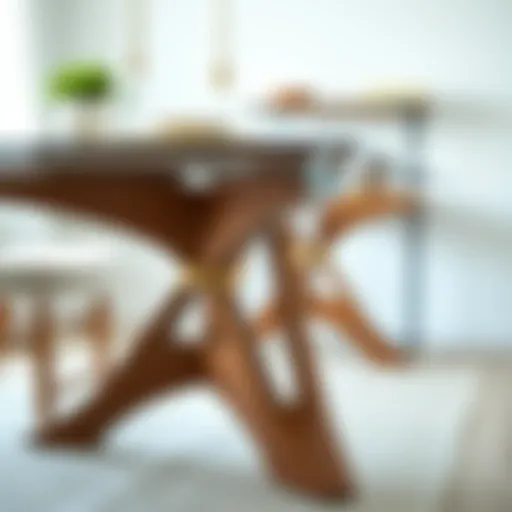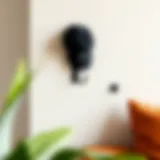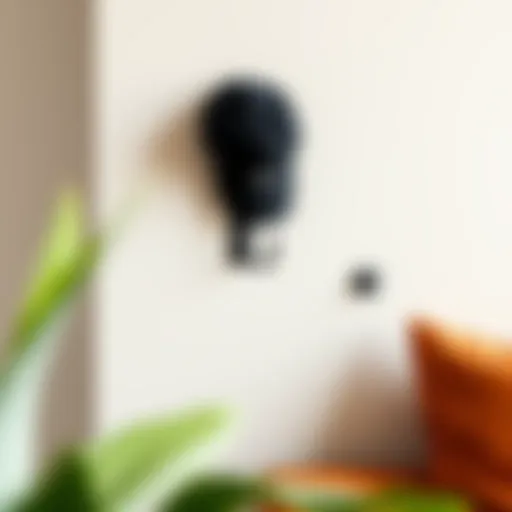The Impact and Style of Black Wood Floor Mirrors
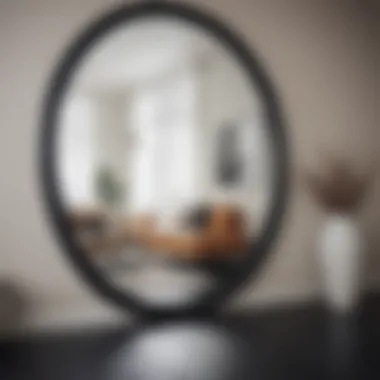

Intro
In the realm of interior design, mirrors are often overlooked as mere practical objects. However, black wood floor mirrors are emerging as pivotal elements that can enhance both the aesthetics and functionality of a space. Their dark, rich tones are not just visually arresting but also add a layer of sophistication, crafting an inviting atmosphere. The versatility of these mirrors makes them suitable for various design styles—whether one leans towards modern minimalism or traditional elegance.
They do more than merely reflect; these mirrors create illusions that augment the depth of a room and contribute to its overall ambiance. Understanding the role they play can significantly influence how we design our living spaces.
Furniture Trends
Current Market Trends
As of recent years, the demand for black wood floor mirrors has surged. With an increasingly stylish homeowner and designer demographic, the marketplace reflects a shift towards sustainable, high-quality materials. Many consumers are now drawn to the idea of incorporating pieces that are not just functional, but also serve as bold statements in their interiors. The ebony finish on wooden mirrors provides a standout contrast, enhancing both light and color elements in any given room.
The trend towards open-plan living spaces also favors the use of these mirrors; they can visually unify different areas of a home while directing light and space in interesting ways.
Popular Styles and Designs
There are several types of black wood floor mirrors that resonate with different tastes and styles. Here is a look at some popular designs:
- Framed Floor Mirrors: These mirrors often feature intricate woodwork, combining style with artistry. Their frames can be simple or ornate, complementing various themes.
- Leaner Mirrors: With a casual elegance, leaner mirrors are designed to be propped against walls; their size can create an open, airy feel in any room.
- Vintage-Inspired Designs: Many are looking to history for inspiration. Vintage designs can evoke nostalgia while fitting seamlessly into modern spaces.
What is compelling about these styles is their adaptability. Black wood mirrors can coexist with bright-colored walls or be paired with neutral tones, allowing flexibility in design choices.
"Mirrors are not just reflections—they are opportunities to redesign how a space feels."
DIY Projects
Step-by-Step Guides
For homeowners looking to customize their black wood floor mirrors, DIY projects can be an enriching experience. From new finishes to creating frames, the opportunities are numerous. Here's a basic guide:
- Select Your Mirror: Choose a plain black wood mirror that complements your space.
- Prep the Area: Ensure you are in a well-ventilated area and have all necessary tools ready—sandpaper, paint, and brushes.
- Sanding: Lightly sand the frame to allow new paint to adhere better.
- Painting/Staining: Apply a fresh coat of paint or stain to achieve the desired shade or texture.
- Finishing Touches: Once dry, add a protective finish to maintain the surface and ensure longevity.
Budget-Friendly Ideas
Creating beauty doesn’t have to break the bank. Here are some budget-friendly ideas to spruce up your black wood floor mirrors:
- Rescue an Old Mirror: A vintage find can often be refreshed with paint or new hardware.
- Accessorize with Decor: Use plants or small accent furniture around the mirror to create a curated look.
- Personal Touches: Add a photo collage or wall art nearby for a customized feel.
Taking the time to integrate black wood mirrors into your décor can amplify the style of your home. With their mix of elegance and practicality, these mirrors can be essential components in crafting your perfect living environment.
Foreword to Black Wood Floor Mirrors
When it comes to interior design, the right elements can make or break a space. Black wood floor mirrors are one such element that brings a considerable impact. They serve not just as reflective surfaces, but as statement pieces that can uplift the aesthetic appeal of an entire room. These mirrors invite light, amplifying both space and style—a crucial factor for homeowners seeking to create an ambiance that feels both welcoming and chic.
Black wood floor mirrors possess a unique versatility that allows them to blend seamlessly into various design styles. Whether you're leaning toward a more minimalist aesthetic or something a bit more bohemian, the sleek, dark hue of these mirrors acts as both a backdrop and a highlight within any environment.
Defining Black Wood Floor Mirrors
Black wood floor mirrors, as the name suggests, are full-length mirrors that stand on the floor, usually mounted within a frame made of black wood. This framing creates a striking contrast against many wall colors and furniture items, offering a touch of elegance and boldness. It's important to note that these mirrors are not merely functional but are also artistic elements in their rights.
- Size Variability: Ranging from tall and slim to wide and sprawling, the size can vary significantly based on the desired impact.
- Frame Styles: Frames may range from traditional to modern, incorporating various wood grains that affect the overall artistic impression.
- Placement Flexibility: They can be situated in different areas, such as living rooms, bedrooms, or hallways, serving distinct purposes and aesthetic functions in each context.
Each of these qualities establishes a foundation for understanding the profound role that black wood floor mirrors can play in living spaces.
Historical Context of Mirrors in Interior Design
The history of mirrors is steeped in cultural significance and evolving trends, dating back thousands of years. In ancient times, mirrors were typically crafted from polished stone or metal, serving as symbols of wealth and vanity. The transition to glass mirrors marks a pivotal shift in how these objects were perceived and utilized.
The adoption of glass mirrors in the Middle Ages allowed ordinary folks to enjoy reflections, transitioning from mere luxury items to staple household decorations. As centuries passed, mirrors have continually evolved alongside design preferences—each era bringing new artistic expressions and functional advancements.
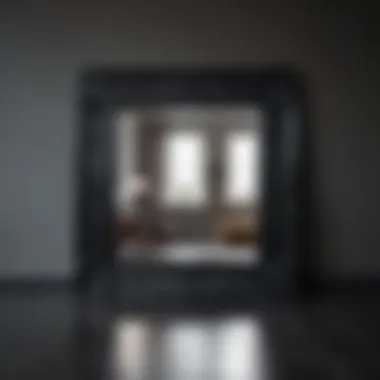

- Renaissance Period: Mirrors became essential in grand hallways and rooms, acting as tools to enhance natural light within dark spaces.
- Victorian Era: The ornamental aspects of mirrors took center stage, with elaborate frames becoming a hallmark of elegant decor.
- 20th Century Modernism: A shift toward minimalism led to simpler designs, paving the way for the sleek, accessible mirrors we see today.
In contemporary design, black wood floor mirrors hold a unique position, blending historical elegance with modern utility. Their continued evolution showcases not only the timeless appeal of mirrors but also their integral role in shaping spatial experiences within homes and public spaces.
Aesthetic Qualities of Black Wood Floor Mirrors
The topic of aesthetic qualities in black wood floor mirrors cannot be overstated. These mirrors are not merely functional objects; they serve as vital elements that enhance the overall ambiance of a room. When it comes to interior design, aesthetic appeal often sets the tone for how a space feels and functions. Black wood floor mirrors bring a touch of sophistication and elegance to various design styles, while also being flexible enough to fit in multiple settings.
Visual Impact in Modern Spaces
In contemporary interiors, black wood floor mirrors stand out. Their sleek lines and rich color create a bold statement that catches the eye. Imagine walking into a room where you are welcomed by the striking silhouette of a tall, black wood mirror reflecting the space. It not only showcases the room but also expands it visually, creating a sense of depth and openness. This visual impact is particularly pronounced in rooms that lean towards minimalism, where furniture is sparse, and every piece must count. The mirror acts like a portal, pulling the viewer's gaze deeper into the room.
Contrast and Harmony in Color Theory
A crucial element of black wood floor mirrors is their ability to work with other colors, thanks to the versatile nature of black. In color theory, black can balance out bright hues or complement softer pastels. This interplay can lift the entire aesthetic of a room. For instance, pairing a black mirror with warm-colored walls can ground the space, providing contrast without overwhelming it. It's like adding salt to a dish—it enhances the whole flavor profile. When used wisely, black mirrors can create harmony within a palette, making them an invaluable asset in any space.
Stylish Pairing with Other Furniture
The aesthetic appeal of black wood floor mirrors also lies in their ability to seamlessly blend with various types of furniture. From chic sofas to rustic tables, these mirrors can be styled to reflect the unique character of the room. As such, it is often beneficial to consider the types of materials around. For instance, a black mirror can provide an elegant counterpoint to a room furnished with lighter woods or metals, creating a dynamic visual contrast. Additionally, it’s curious how the style of the mirror—whether ornate or minimalistic—can complement or challenge the surrounding furniture, guiding the viewer's experience throughout the space.
Black wood floor mirrors certainly exude a sense of style and elegance. Incorporating them into living spaces does not only elevate the visual attraction but also invites a deeper appreciation of the complexity involved in modern interior design.
Functional Benefits of Black Wood Floor Mirrors
Black wood floor mirrors are not merely decorative elements in a room; they carry substantial functional weight. These pieces serve multiple roles in enhancing living spaces while also offering practical benefits that cater to the diverse needs of homeowners, renters, and designers. Understanding these functional aspects can help one make informed decisions that elevate not only style but also usability in their chosen environment.
Enhancing Spatial Perception
One of the primary functional advantages of black wood floor mirrors is their ability to enhance spatial perception. Mirrors can create an illusion of depth and expansiveness, especially in smaller rooms. When strategically placed, they can trick the eye into perceiving more space than what is truly there. For instance, a well-positioned black wood mirror in a narrow hallway can reflect light and expand the visual horizon, giving an airy feeling.
Moreover, this kind of flooring mirror can also help delineate areas within open-plan spaces. By reflecting various elements, they can visually “divide” areas while maintaining an open feel. The contrast of the black wood against different colors creates a focal point, guiding the eye without overwhelming the senses.
"A mirror is not just a reflection; it can be a window to endless possibilities in spatial design."
Light Reflection and Ambiance
Another essential benefit lies in how black wood floor mirrors interact with light. They are masters of reflecting light—natural or artificial—which helps in brightening up spaces that might feel a bit dim or cramped. A strategically placed mirror can bounce sunlight across a room, minimizing the need for artificial lighting during daytime, which can save on energy costs.
In terms of ambiance, these mirrors can transform a flat atmosphere into something vivid. A black wood mirror can add a layer of sophistication that uplifts the mood of the entire area. Consider a living room outfitted with warm, ambient lighting. A black wood floor mirror can amplify this effect by reflecting soft glows and creating dynamic lighting that brings energy and warmth into the space.
Additionally, the unique finish of black wood brings a nuanced quality to light reflections, often lending a slight sheen that creates depth and richness in any room. Such reflections are not mere copies; they can tell a story of elegance and poise.
Through these functional benefits—enhancing spatial perception and altering light dynamics—black wood floor mirrors stand out as remarkable assets in effective interior design. They are tools that empower individuals to maximize their living or working environment while also satisfying aesthetic desires.
Design Styles Incorporating Black Wood Floor Mirrors
In the realm of interior design, black wood floor mirrors serve as versatile components that enhance various styles and aesthetics. Their presence is not merely decorative – it’s transformational. They breathe life into spaces, adding depth and dynamism. This section explores how these mirrors fit into several design styles, showcasing their adaptability and the unique character they bring to each one. Understanding these styles can help homeowners, designers, and DIY enthusiasts make informed choices that resonate with their overall vision of a space.
Minimalist Aesthetics
Minimalism is all about simplicity and function, stripping down the decor to essential elements while maintaining an air of sophistication. Black wood floor mirrors fit seamlessly within minimalist designs, providing just the right touch of elegance without overwhelming the space. The dark finish allows them to blend into the background when needed, while the reflective surface opens up the room, creating an illusion of more space.
When selecting a black wood floor mirror for a minimalist setting, look for clean lines and geometric shapes. A large mirror with a simple frame can act as a statement piece, reflecting light and drawing the eye without adding clutter. Here, less truly becomes more, proving that black wood mirrors can elevate minimalist design, striking a balance between functionality and aesthetics.
Industrial Chic
Industrial chic brings together raw materials and vintage elements, a style that's both rugged and refined. Black wood floor mirrors play an important role in achieving this trendy look. Their sleek, dark wood allows them to harmonize with metal fixtures and distressed surfaces typically found in industrial settings. These mirrors soften the strong lines of metal and concrete, adding warmth and dimension.
Incorporating a black wood mirror in an industrial space can also serve as a focal point, contrasting nicely against exposed brick or concrete walls. A well-placed mirror can reflect industrial light fixtures, enhancing the area’s character. To perfectly align with this aesthetic, opt for mirrors that have a slightly worn or reclaimed appearance, echoing the style’s emphasis on authenticity.
Classic Elegance
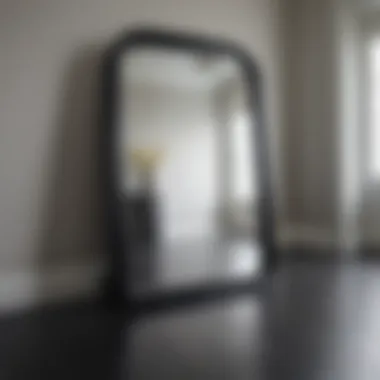

The classic elegance style is synonymous with timeless decor that showcases refined taste. Black wood floor mirrors become essential in this framework, accentuating other traditional elements like ornate frames, rich textiles, and antique furnishings. They blend beautifully with warm wood tones and plush fabrics, creating an inviting and sophisticated atmosphere.
In classic designs, size matters. A large black wood mirror can dominate a wall, establishing a luxurious ambiance while enhancing the space’s overall elegance. The mirror's reflective quality amplifies natural light, giving rooms a warm glow that complements classic colors, like deep blues and rich burgundies. Thus, the synergy between these mirrors and classic design not only enhances beauty but also celebrates the art of traditional decor.
Bohemian Flair
When it comes to Bohemian style, characterized by vibrant colors and eclectic decor, the black wood floor mirror is an unexpected yet potent ally. Its subdued color allows it to ground the often chaotic color palette that defines Bohemian interiors. The mirror can serve as a canvas, reflecting the myriad hues and textures that fill the space.
To embrace this style, consider leaning a black wood mirror against a wall adorned with patterned textiles or an assortment of framed art. Not only does it add depth and interest, but it also reflects the vivacious spirit of Bohemian design. Incorporating decorative elements such as beads or macramé can further enhance the mirror’s bohemian character, allowing it to blend seamlessly into the overall aesthetic.
"Black wood floor mirrors provide more than just function; they become integral players in conveying the unique voice of each design style."
In summary, black wood floor mirrors are not one-size-fits-all; their versatility allows them to enhance and complete various interior design narratives. Whether you lean towards the tranquil aspects of minimalism, the boldness of industrial chic, the timelessness of classic elegance, or the adventurous spirit of Bohemian style, these mirrors have a place in your creative vision.
Choosing the Right Black Wood Floor Mirror
Choosing the right black wood floor mirror is crucial for anyone looking to enhance the aesthetics and functionality of their living space. These mirrors transcend mere reflection; they serve as impactful design elements that can transform an ordinary room into an extraordinary one.
When selecting a black wood floor mirror, several key elements come into play: size, scale, materials, and finishes. Each factor not only influences the visual appeal but also affects how the mirror fits within the overall decor of your home.
The sheer presence of a black wood mirror can anchor your space. It adds depth and a touch of elegance that can harmonize with various design styles, from minimalist to bohemian. Moreover, understanding how to choose the right mirror ensures that it serves its functional purpose—not just to reflect, but also to brighten and expand a room.
Determining Size and Scale
Determining the size and scale of your black wood floor mirror is perhaps one of the most critical steps in your selection process. A mirror that is too small may get lost in a large room, while an oversized one can overwhelm a smaller space.
- Proportion matters: The mirror’s size should complement the overall proportions of the room. If you have high ceilings, a tall mirror could create an illusion of added height; conversely, in a low-ceiling space, a shorter mirror may provide a more grounded feel.
- Consider placement: Think about where you intend to place the mirror. Positioning it near furniture pieces can help visualize the dimensions. For example, placing a tall mirror next to a low-profile sofa encourages eye movement and creates a sense of balance between the two.
- Creating illusions: Strategically choosing sizes can play tricks on the eye. A big mirror can make a cramped space feel open. Conversely, a series of smaller mirrors could produce an interesting gallery effect without overcrowding.
Materials and Finishes
The materials and finishes of a black wood floor mirror contribute significantly to its charm and durability:
- Type of wood: Different types of wood can influence not just the look but also the resilience of your mirror. For instance, oak provides sturdiness and a textured grain, while walnut adds richness and sophistication.
- Finishes: The finish on a black wood mirror affects its sheen and tactile quality. A matte finish tends to evoke a more understated elegance, suitable for modern or minimalist decors. In contrast, a glossy finish can add an element of glamour, reflecting more light and making a bold statement.
- Edge treatments: The edge of the mirror can also impact its style. A framed mirror with intricate carvings might be better suited for classic or vintage spaces, while a sleek, straight-edge mirror aligns more with contemporary aesthetics.
"The beauty of design is in the details, and selecting the right mirror is no exception. It’s about finding that perfect balance between aesthetic allure and practical application."
Placement Strategies for Maximum Impact
The significance of strategic placement of black wood floor mirrors cannot be overstated within interior design. These mirrors serve not only as reflective surfaces but also as focal points that can alter perceptions of space and light. When placed thoughtfully, they can enhance the aesthetics and functionality of any room.
Optimal Locations in Various Rooms
To maximize the impact of black wood floor mirrors, understanding the nuances of room dynamics is vital. Here are some optimal locations to consider:
- Living Room: Positioning a mirror across from a window can amplify natural light and create an inviting ambiance. This positioning not only opens up the room visually but also adds a layer of brightness that enhances the overall atmosphere.
- Hallways: Utilizing narrow spaces for mirrors can help give the illusion of more space. A well-placed black wood floor mirror can turn a cramped corridor into a more spacious passage, providing both function and style.
- Dressing Areas: In homes where space permits a dedicated dressing area, a black wood floor mirror provides practicality and elegance. When placed near clothing storage, it becomes a functional element that streamlines getting dressed while adding style.
- Bedrooms: Here, a mirror can serve a dual purpose. Not only does it provide a space for personal grooming, but it also visually expands the room. Placing the mirror against a feature wall can create a stunning backdrop.
The key here is understanding how the light flows in the room and working with it, rather than against it.
Creating Visual Focal Points
Creating visual focal points within a room is essential for effective design, and black wood floor mirrors play a significant role in achieving this. Placing a mirror strategically can draw the eye, balancing the room's elements or even creating tension where needed. Here are several tips to consider:
- Align with Architectural Features: If there’s a particular feature, such as a fireplace or bookshelf, consider aligning the mirror with it. This creates a cohesive look, establishing a connection between different elements in the room.
- Groupings: Mirrors can be grouped with artwork or other decorative items. A black wood floor mirror can work to elevate the look of framed prints or sculptures, adding layers to the design.
- Accent Walls: If your wall has an interesting texture or color, a mirror can deepen that effect by reflecting it. This doesn’t just create depth in the flatness of the wall, it also adds visual intrigue.
- Height Variation: Place the mirror at varying heights to create dynamics within the space. For example, a tall mirror positioned next to lower furniture can draw attention vertically, hence drawing the eye upwards.
Tip: Experiment with placements before making a commitment. Comparing different angles and adjacencies can reveal surprising enhancements to your room’s design.
Maintenance of Black Wood Floor Mirrors
Maintaining black wood floor mirrors is crucial to keeping their aesthetic appeal and extending their durability. Mirrors serve both functional and decorative roles in a home, reflecting light and enhancing the overall ambiance. When well cared for, these mirrors can become timeless pieces that elevate any space. Ignoring their upkeep, however, can lead to scratches, smudges, and a loss of their lustrous charm. This section delves into practical cleaning techniques and preventive measures that will ensure these elegant fixtures continue to shine for years to come.
Cleaning Techniques and Tips
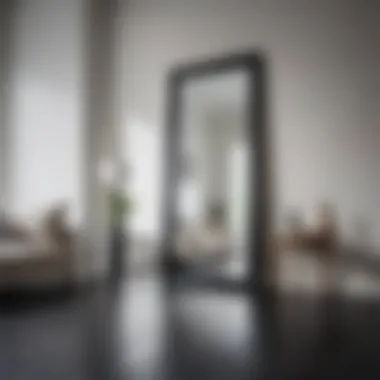

When it comes to cleaning black wood floor mirrors, simplicity is key. The goal should be to avoid harsh chemicals that can damage both the glass and wooden surfaces. Here are some effective techniques:
- Use a Soft Cloth: A lint-free cloth is ideal. Microfiber cloths work wonders as they pick up dust without scratching.
- Mild Cleaning Solution: A mixture of warm water with a few drops of liquid dish soap serves as a great cleaner. Just dampen your cloth with this solution and gently wipe down the glass.
- Avoid Excess Water: While moisture is essential, too much of it can seep into the wooden frame, causing warping or damage. It’s best to wring out excess liquid from your cloth before using it.
- Dry Thoroughly: After cleaning, use a dry cloth to ensure no water remains on the surface or joints. This step is crucial to prevent any future mold or mildew issues.
- Frequency Matters: Aim to clean your mirror at least once a month or more often if it’s in a high-traffic area. A regular regimen keeps it looking fresh and functional.
"A clean mirror reflects the best moments of our lives, both literally and metaphorically."
Preventing Damage and Longevity
To preserve and prolong the life of black wood floor mirrors, preventive care is necessary. Here are some steps to consider:
- Positioning Wisely: Avoid placing the mirror in direct sunlight, as constant exposure can fade the wood's color and alter the integrity of the mirror’s reflection over time.
- Use Protective Coatings: Applying a wood conditioner or polish designed for black finishes can help protect the wood from scratches and moisture. This also gives an added layer of shine to the mirror frame.
- Mindful Decor: Be cautious with items placed near the mirror. Gritty coasters or rough decorative objects can inadvertently scratch the wooden surface. Opt for smooth, soft decorations around your mirror area to minimize risk.
- Regular Inspections: An occasional check on the overall condition, looking for any early signs of wear and tear, will help catch potential problems before they escalate.
- Professional Care: Don’t hesitate to call a professional for a deeper cleaning or restoration if you notice significant wear. This can be especially beneficial for vintage pieces or heirlooms.
Sustainability Considerations in Furniture Choices
When it comes to interior design, the focus is often on aesthetics and functionality. However, in today’s world, the conversation has expanded to include sustainability. Investing in furniture, such as black wood floor mirrors, isn't only about creating an appealing space anymore; it’s also about making choices that won’t harm the environment. In this section, we will explore why sustainability matters and what key elements to consider when selecting furniture.
Ethical Sourcing of Materials
Choosing furniture that incorporates ethically sourced materials can transform the impact one has on the environment. Ethical sourcing refers to ensuring that the materials used are obtained in a way that respects environmental health, upholds human rights, and promotes fairness.
For example, when considering black wood floor mirrors, one should look for brands that can trace their wood back to managed forests. This is crucial because unmanaged logging can lead to deforestation and ecological distress.
To understand better:
- Transparency is key: Brands should provide information on the origins of their materials.
- Certifications matter: Look for certifications like FSC (Forest Stewardship Council), which ensure sustainable practices.
- Local sourcing: Furniture made from locally sourced materials reduces carbon footprints related to transportation, contributing to sustainability.
By choosing companies that prioritize these values, consumers not only support responsible forestry practices but also promote a market that values sustainability.
"An investment in sustainable furniture is an investment in the future health of our planet."
Eco-friendly Wood Options
Now, let's talk about eco-friendly wood options. Not all wood is created equal, and some choices are better for the environment than others. Hardwoods like oak and maple are popular but can be less sustainable when sourced irresponsibly. However, there are alternatives that have a smaller ecological footprint.
Consider these options:
- Bamboo: Fast growing and renewable, bamboo can be a superb substitute for traditional hardwoods.
- Reclaimed wood: This material, salvaged from old buildings or furniture, reduces waste, and brings a unique character to new pieces.
- Alternative materials: Some modern designs incorporate materials like MDF, produced from recycled wood, which drastically lowers the need for fresh lumber.
When selecting a black wood floor mirror, checking the type of wood used can make all the difference in sustainability. Opting for eco-friendly materials means investing in pieces that not only enhance the home but also contribute positively to the environment.
In summary, sustainability considerations are an essential aspect of choosing furniture. By focusing on ethical sourcing and eco-friendly materials, homeowners and designers can ensure that their choices align with a more sustainable future.
Ending: The Lasting Appeal of Black Wood Floor Mirrors
The exploration of black wood floor mirrors throughout this article reveals their significant place in contemporary interiors. These exquisite pieces not only serve as functional objects but also act as bold statements in home design. The allure of black wood floor mirrors lies in their perfect blend of style and utility, making them indispensable for any modern space.
In summary, we have discussed several key aspects:
- Aesthetics: The visual impact of these mirrors, paired with their ability to complement various design styles, enhances both small and expansive spaces. They can draw attention or blend seamlessly with their environment.
- Functionality: These mirrors amplify light, create an illusion of space, and serve as useful tools for daily dressing routines. Their versatility is unmatched.
- Design Integration: From minimalist schemes to bohemian flair, the adaptability of black wood mirrors makes them a fitting accessory in any room.
Moreover, a crucial consideration is maintenance—taking proper care ensures longevity, making them a smart investment for homeowners. Whether you're looking to elevate your space or simply add a touch of elegance, these mirrors prove their worth time and again.
"The right mirror can truly transform a space, opening it up to light and beauty, while providing functionality and style all at once."
Summarizing Key Points
As we wrap up, let’s recap the essentials surrounding black wood floor mirrors:
- They enhance aesthetic value through their striking presence.
- They improve the perception of space and light within a room.
- Their design versatility allows them to fit into myriad styles effortlessly.
- Proper maintenance practices contribute significantly to their longevity and function.
By considering these aspects, anyone looking to incorporate black wood floor mirrors into their home will not only appreciate their beauty but also their multifaceted role in interior design.
Future Trends in Mirror Design
Looking ahead, several trends are poised to shape the future of mirror design:
- Sustainable Materials: An increasing focus on eco-friendly materials will lead to the development of mirrors that not only look good but are also ethically sourced.
- Smart Technology Integration: With advances in home tech, it wouldn’t be surprising to see mirrors equipped with features like smart lighting and displays, enhancing their function even further.
- Unique Shapes and Styles: As individual taste continues to evolve, expect to see a rise in mirrors of unconventional shapes and artistic designs, emphasizing personal expression.
- Maintenance Innovations: Future designs might include self-cleaning materials or coatings to reduce upkeep and enhance longevity.


